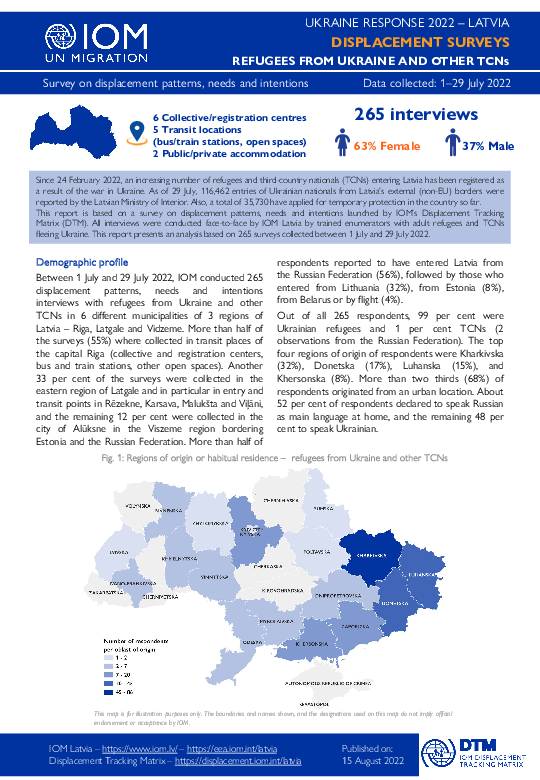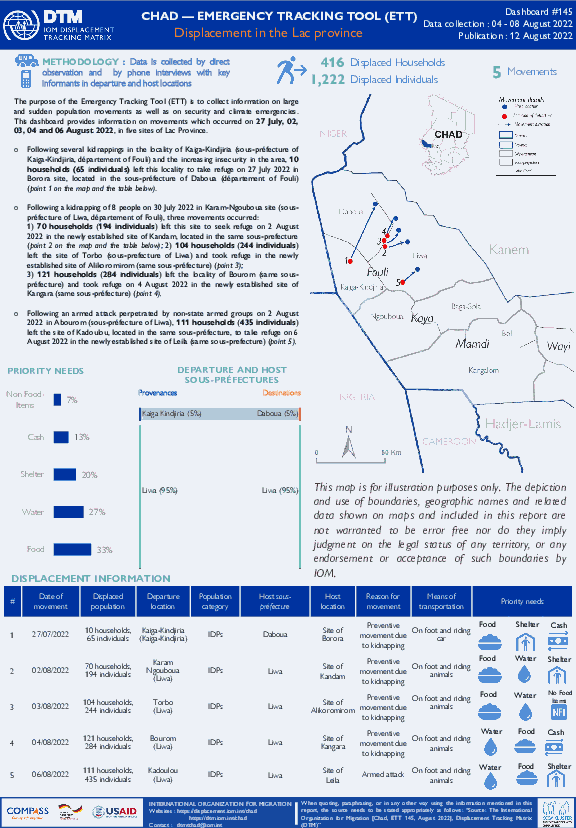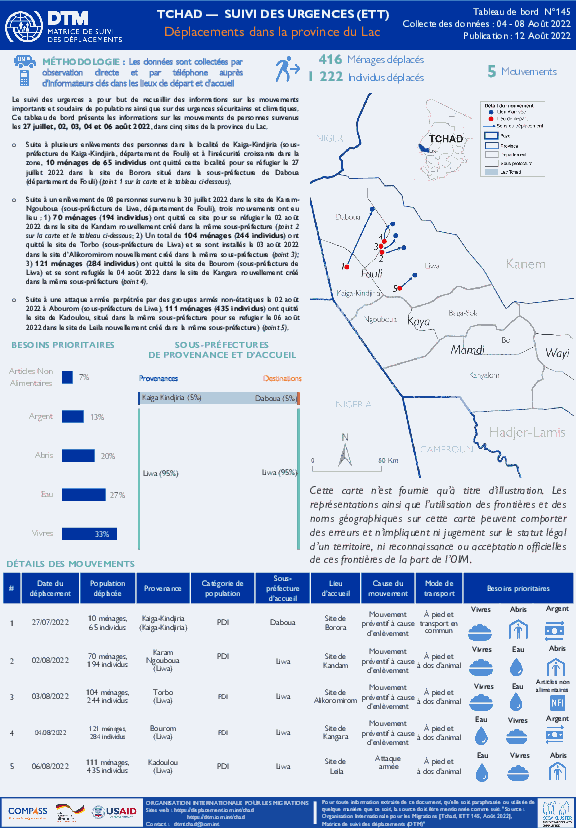-
Countries
-
Data and Analysis
-
Special Focus
-
Crisis Responses
The Central American, North American, and Caribbean region has been characterised by large migratory movements. The countries of the region see the emergence of those movements, act as transit countries, and at the same time form the destinations and the points of reception of many of the migrants. It is estimated that at the end of 2021, at least 130,000 migrants reached Panama through the Darién route.
During 2021, DTM activities took place in 13 countries in the region, including flow monitoring registries and surveys in 90 bordering locations, as well as surveys of resident populations, returned migrants, and displaced persons. According to the surveys, the most common drivers of migration were the lack of job opportunities, insufficient income, the impact of COVID-19, and violence. Drought in Honduras and the recent earthquake in Haiti also contributed to internal displacement. The main needs identified were: income or employment, food, access to basic services, health and education, and legal advice. The statistics produced through DTM activities show high numbers of cross-border movements, the majority of which were monitored between the border of Haiti and the Dominican Republic. There are also large numbers of returned individuals and persons internally displaced due to natural disasters.

Contact
DTM Europe, DTMMediterranean@iom.int
Language
English
Location
Latvia
Period Covered
Jul 01 2022
Jul 29 2022
Activity
- Survey
- Flow Monitoring
Since 24 February 2022, an increasing number of refugees and third-country nationals (TCNs) entering Latvia has been registered as a result of the war in Ukraine. As of 29 July, 116,462 entries of Ukrainian nationals from Latvia’s external (non-EU) borders were reported by the Latvian Ministry of Interior. Also, a total of 35,730 have applied for temporary protection in the country so far.
This report is based on a survey on displacement patterns, needs and intentions launched by IOM’s Displacement Tracking Matrix (DTM). All interviews were conducted face-to-face by IOM Latvia by trained enumerators with adult refugees and TCNs fleeing Ukraine. This report presents an analysis based on 265 surveys collected between 1 July and 29 July 2022.
Czechia
IDPs tracked
Displacement Movements
No figure is available
IDMC 2023
Data collection round

Contact
DTM Yemen, iomyemendtm@iom.int
Language
English
Location
Yemen
Period Covered
Aug 07 2022
Aug 13 2022
Activity
- Mobility Tracking
IOM Yemen DTM’s Rapid Displacement Tracking (RDT) tool collects data on estimated numbers of households forced to flee on a daily basis from their locations of origin or displacement, allowing for regular reporting of new displacements in terms of estimated numbers, geography, and needs. It also tracks returnees who returned to their location of origin.
From 1 January to 13 August 2022, IOM Yemen DTM tracked 8,151 households (HH) (48,906 Individuals) who experienced displacement at least once.
Between 7 and 13 August 2022, IOM Yemen DTM tracked 423 households (2,538 individuals) displaced at least once. The majority of people moved into/within the following governorates and districts:
- Shabwah (313 HHs) – Ataq (141 HHs), Markhah As Sufla (49 HHs), Ar Rawdah (46 HHs) districts. All displacements in the governorate were internal.
- Marib (88 HHs) – Marib City (63 HHs), Marib (18 HHs), Harib (7 HHs) districts. Most displacements in the governorate originated from Marib and Shabwah.
- Taiz (11 HHs) – Al Mudhaffar (4 HHs), Al Qahirah (4 HHs), Al Makha (2 HHs) districts. Most displacements in the governorate originated from Al Hodeidah and Taiz.
The majority of people moved from the following governorates and districts:
- Shabwah (325 HHs) – Ataq (313 HHs), Bayhan (8 HHs), Osaylan (4 HHs) districts.
- Marib (56 HHs) – Marib City (40 HHs), Raghwan (8 HHs), Harib (7 HHs) districts.
- Al Hodeidah (19 HHs) – Al Marawiah (6 HHs), Hays (5 HHs), Az Zuhrah (3 HHs) districts.
Contact
DTM Yemen, iomyemendtm@iom.int
Location
Yemen
Activity
- Mobility Tracking
- Event Tracking
Period Covered
Aug 07 2022 -Aug 13 2022
From 1 January to 13 August 2022, IOM Yemen DTM tracked 8,151 households (HH) (48,906 Individuals) who experienced displacement at least once.
Between 7 and 13 August 2022, IOM Yemen DTM tracked 423 households (2,538 individuals) displaced at least once. The majority of people moved into/within the following governorates and districts:
- Shabwah (313 HHs) – Ataq (141 HHs), Markhah As Sufla (49 HHs), Ar Rawdah (46 HHs) districts. All displacements in the governorate were internal.
- Marib (88 HHs) – Marib City (63 HHs), Marib (18 HHs), Harib (7 HHs) districts. Most displacements in the governorate originated from Marib and Shabwah.
- Taiz (11 HHs) – Al Mudhaffar (4 HHs), Al Qahirah (4 HHs), Al Makha (2 HHs) districts. Most displacements in the governorate originated from Al Hodeidah and Taiz.
- Shabwah (325 HHs) – Ataq (313 HHs), Bayhan (8 HHs), Osaylan (4 HHs) districts.
- Marib (56 HHs) – Marib City (40 HHs), Raghwan (8 HHs), Harib (7 HHs) districts.
- Al Hodeidah (19 HHs) – Al Marawiah (6 HHs), Hays (5 HHs), Az Zuhrah (3 HHs) districts.
Population Groups
Survey Methodology
Unit of Analysis Or Observation
Type of Survey or Assessment
Keywords
Geographical Scope
Administrative boundaries with available data
The current dataset covers the following administrative boundaries

Contact
DTM Chad, dtmtchad@iom.int
Language
English
Location
Chad
Period Covered
Aug 04 2022
Aug 08 2022
Activity
- Mobility Tracking
- Event Tracking
The purpose of the Emergency Tracking Tool (ETT) is to collect information on large and sudden population movements as well as on security and climate emergencies. This dashboard provides information on movements of 1,222 persons which occurred on 27 July, 02, 03, 04 and 06 August 2022, in five sites of Lac Province

Contact
DTM Tchad, dtmtchad@iom.int
Language
French
Location
Chad
Period Covered
Aug 04 2022
Aug 08 2022
Activity
- Mobility Tracking
- Event Tracking
Le suivi des urgences a pour but de recueillir des informations sur les mouvements importants et soudains de populations ainsi que sur des urgences sécuritaires et climatiques. Ce tableau de bord présente les informations sur les mouvements de 1 222 personnes survenus les 27 juillet, 02, 03, 04 et 06 août 2022, dans cinq sites de la province du Lac.

Contact
DTM Mozambique, DTMMozambique@iom.int
Language
English
Location
Mozambique
Period Covered
Jul 11 2022
Aug 27 2022
Activity
- Other
Following the recent attacks in Mitepo locality (Meluco district), the IOM’s DTM team continue to track IDP movement across Cabo Delgado. An estimated 2,009 individuals (585 households) were displaced to Meluco sede. Among the the displaced individuals, 14 were identified with vulnerabilities. 3 unacompained/separated children, 3 pregnant women, 2 elderly, 3 people with disabilities, and 3 people with chronic disease.
73 per cent of the estimated individuals movements were arrivals originated within Meluco district (Mitepo and Sitate localities), while 27 per cent were departures from Ancuabe district (Nacuale, Ngura and Minheuene localities). Of the total displaced population, 7 per cent of mobile groups were displaced for the First time, and 67 per cent of reported individuals have been displaced more than once prior to this movement.

Contact
DTMMozambique@iom.int
Language
English
Location
Mozambique
Period Covered
Jul 27 2022
Aug 02 2022
Activity
- Mobility Tracking
- Event Tracking
During the reporting period (27 July to 02 August 2022), a total of 75 movements were recorded - 43 arrivals (2,608 individuals), 17 departures (1,019 individuals), 13 returns (1,176 individuals), and 2 transits (115 individuals). The largest arrival movements were recorded in Meluco (1,009 individuals), Metuge (455 individuals), and Ancuabe (385 individuals). The largest departure movements were recorded in Cidade de Pemba (483 individuals) and Nangade (385 individuals). The largest return movement was observed in Palma (708 individuals) and Montepuez (282 individuals). The largest transit movement was observed in Mueda (115 individuals). Of the total population, 30 per cent of mobile groups were displaced for
the first time, and 70 per cent of reported individuals have been displaced more than once prior to this movement.



